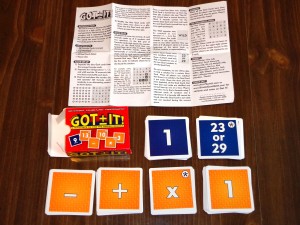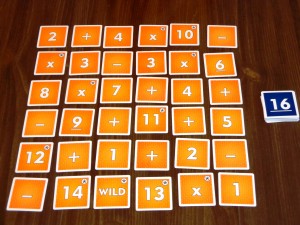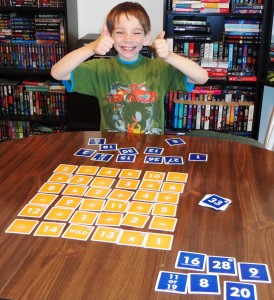I never understood why schools insisted on going over trivial things that we’d end up forgetting as adults anyway…after all, isn’t that what research is for? What’s the expression…”teach a man to fish…?” I don’t remember what the Scarlet Letter was about, just that the Custom House introductory was painful and could be considered cruel and unusual punishment. I don’t remember a thing about the Aztecs or who the twenty-second President of the United States was. Though, I do remember a thing or two about math and English, mainly because I use both more than any other school subject I was taught. It’s for this reason that I encourage kids everywhere to play educational games that improve both basic math, reading, and writing skills.
Editor’s Note: The recommended age on the box is 13+, however I personally can see the minimum age being between 8 and 10.
Got It! is an educational game that flexes the math muscles of your brain. Players will be trying to find formulas that match the number listed on goal cards. Before I go any further, I’d like to thank Tom Jolly from Jolly Games for sending me a free copy to review. Tom is the same person who sent me WayWord to review, which you can find here:
Let’s take a quick look at the components & gameplay before heading into the review.
Components
Goal Cards – These blue, square cards each have a number printed on them. This serves as the number that players will be trying to solve for. The numbers range from one to forty, though some of them have more than one number on them. There are thirty-four goal cards in all.
Numeral and Operator Cards – The orange, square cards either have a number or an operator printed on them. Players will be using a combination of these cards to solve for the numeral listed on the goal card. There are eighteen operator cards and eighteen numeral cards. The wild card serves as any operator found in the game (+, -, x), though the rules state that you can choose any operator you wish if you want to stretch your brain a little.
Setup & Gameplay
In the normal game, a six by six grid of orange cards are laid out. This is done by shuffling the operator cards and the numeral cards separately, then placing them alternately on the table. No operator should be adjacent to another operator and no numeral should be adjacent to another numeral. The blue goal cards are shuffled and one is drawn, revealing the number for all to see.
Next, the players must all look at the grid and see what combination of orange cards would meet the number on the goal. The equation must be five cards long (two operators and three numbers), and the numbers / operators being used must be adjacent to one another. It is not necessary to find a combination of cards that are in a straight line, just so as long as they are adjacent. While the rules that came with the game don’t mention it, imaginary parentheses can be used in whatever fashion you can conjure up to configure the order of operations. 3 + 4 X 2, for example, could instead be (3+4) x 2, which will give you a different answer.
When a player discovers the five-card combination that solves for the number on the goal card, they proclaim, “Got It!” and show everyone the equation. If players agree that the equation is correct, the proclaiming player gets the goal card. If there is an instance where there is no solution to a goal card and players agree, they can move on to the next one.
The next goal card is drawn, and the process repeats. The player with the most goal cards at the end of the game wins!
The Review
First, I want to praise the flexibility of this game. To make the game easier, you can draw a five by five orange grid, use only addition and subtraction operators, and arrange the deck so that the goal cards only range from one through twenty. The cards make it easy for you in separating them, as anything without an asterisk on it is used for the beginner’s game. I’ve developed a variant that involves laying out all of the goal cards at once, and players are free to pick and choose which cards they want to solve for. As players find equations, they show the others which orange cards were used, and then take the goal card. All of these variants can be used in a cooperative fashion as well as spark a little competition.
Regardless of which way you play this game, it is highly educational. Solving problems in reverse is not only a great way to promote creative thinking but to strengthen one’s math skills. I can use this game any time I wish to help the kids practice their math. All I have to do is lay out the cards and let them go at it individually or cooperatively and see how many equations they can find.
I played the game with my eleven year old son Vinnie (the rest were on vacation at the time) and he really enjoyed it. He rattled on, nonstop, saying equations outloud until he got the goal card shown. He’d laugh in an “Ohh man” kind of way when the equation was one number off from the solution…it was rather cute. The lower numbers were much easier for him, and I admit that the larger numbers had me thinking for a few minutes. Still, he managed to get some of the high numbers by using a combination of operators that even I hadn’t seen. It was a brain teaser for the both of us and we were equally enjoying our experience.
Overall, this game would make an excellent addition to any household. I’ll take that a step farther and say that every school and classroom should have this game in their collection. It promotes learning in a fun way, which is how it should be. As an accountant and father, I back this game one hundred percent.
Final Verdict: 8/10
You can read more about this game by visiting Jolly Games and Board Game Geek, located here:
—



